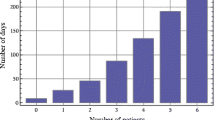Abstract
The main aim of this paper is to derive a solution to the capacity problem faced by many perinatal networks in the United Kingdom. We propose a queueing model to determine the number of cots at all care units for any desired overflow and rejection probability in a neonatal unit. The model formulation is developed, being motivated by overflow models in telecommunication systems. Exact expressions for the overflow and rejection probabilities are derived. The model is then applied to a neonatal unit of a perinatal network in the UK.
Access this article
We’re sorry, something doesn't seem to be working properly.
Please try refreshing the page. If that doesn't work, please contact support so we can address the problem.
Similar content being viewed by others
References
Abdalla, N., & Boucherie, R. J. (2002). Blocking probabilities in mobile communications networks with time-varying rates and redialing subscribers. Annals of Operations Research, 112, 15–34.
Asaduzzaman, M., & Chaussalet, T. J. (2008). Modelling and performance measure of a perinatal network centre in the United Kingdom. In Proceedings of the 21th IEEE international symposium on computer-based medical systems (pp. 506–511).
BLISS (2005). Neonatal Services—are they improving? BLISS—The Premature Baby Charity.
Boucherie, R. J., & Mandjes, M. (1998). Estimation of performance measures for product form cellular mobile communications networks. Telecommunication Systems, 10, 321–354.
Chaussalet, T. J., Xie, H., & Millard, P. (2006). A closed queueing approach to the analysis of patient flow in health care systems. Methods of Information in Medicine, 5, 492–497.
Davis, J. L., Massey, W. A., & Whitt, W. (1995). Sensitivity to the service-time distribution in the nonstationary Erlang loss model. Management Science, 41(6), 1107–1116.
DH (2005). Report of the neonatal intensive care services review group. Department of Health.
Erhardsson, T. (2001). On the number of lost customers in stationary loss systems in the light traffic case. Queueing Systems, 38(1), 25–47.
Ferreira, R. B., Coelli, F. C., Pereira, W. C., & Almeida, R. M. (2008). Optimizing patient flow in a large hospital surgical centre by means of discrete-event computer simulation models. Journal of Evaluation in Clinical Practice, 14, 1031–1037.
Gła̧bowski, M., Kubasik, K., & Stasiak, M. (2008). Modeling of systems with overflow multi-rate traffic. Telecommunication Systems, 37, 85–96.
Griffiths, J. D., Price-Lloyds, N., Smithies, M., & Williams, J. (2006). A queueing model of activities in an intensive care unit. IMA Journal of Management Mathematics, 17(3), 277–288.
Jiang, L., & Giachetti, R. E. (2008). A queueing network model to analyze the impact of parallelization of care on patient cycle time. Health Care Management Science, 11, 248–261.
Kelly, F. P. (1979). Reversibility and stochastic networks. Chichester: Wiley.
Kelly, F. P. (1991). Loss network. Annals of Applied Probability, 1(3), 319–378.
Kim, S. C., Horowitz, I., Young, K. K., & Buckley, T. A. (1999). Analysis of capacity management of the intensive care unit in a hospital. European Journal of Operational Research, 115(1), 36–46.
Koizumi, N., Kuno, E., & Smith, T. E. (2005). Modelling patient flows using a queuing network with blocking. Health Care Management Science, 8(1), 49–60.
Kortbeek, N., & van Dijk, N. M. (2007). On dimensioning intensive care units. AENORM, 57, 22–26.
Litvak, N., van Rijsbergen, M., Boucherie, R. J., & van Houdenhoven, M. (2008). Managing the over flow of intensive care patients. European Journal of Operational Research, 185(3), 998–1010.
Parmanum, J., Field, D., Rennie, J., & Steer, P. (2000). National census of availability of neonatal intensive care. British Medical Journal, 321(7263), 727–729.
RCPCH (2007). Modelling the future: A consultation paper on the future of children’s health services. Royal College of Paediatrics and Child Health.
Ridge, J., Jones, S., Nielsen, M., & Shahani, A. (1998). Capacity planning for intensive care units. European Journal of Operational Research, 105(2), 346–355.
Sendfeld, P. (2008). Two queues with weighted one-way overflow. Methodology and Computing in Applied Probability, 10(4), 531–555.
van Dijk, N. M. (1993). Queueing networks and product forms: a systems approach. Chichester: Wiley.
Author information
Authors and Affiliations
Corresponding author
Rights and permissions
About this article
Cite this article
Asaduzzaman, M., Chaussalet, T.J. & Robertson, N.J. A loss network model with overflow for capacity planning of a neonatal unit. Ann Oper Res 178, 67–76 (2010). https://doi.org/10.1007/s10479-009-0548-x
Published:
Issue Date:
DOI: https://doi.org/10.1007/s10479-009-0548-x




